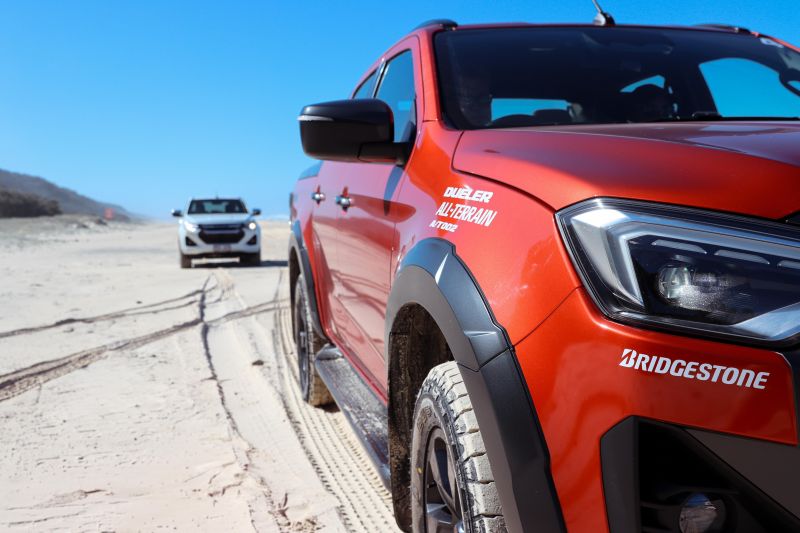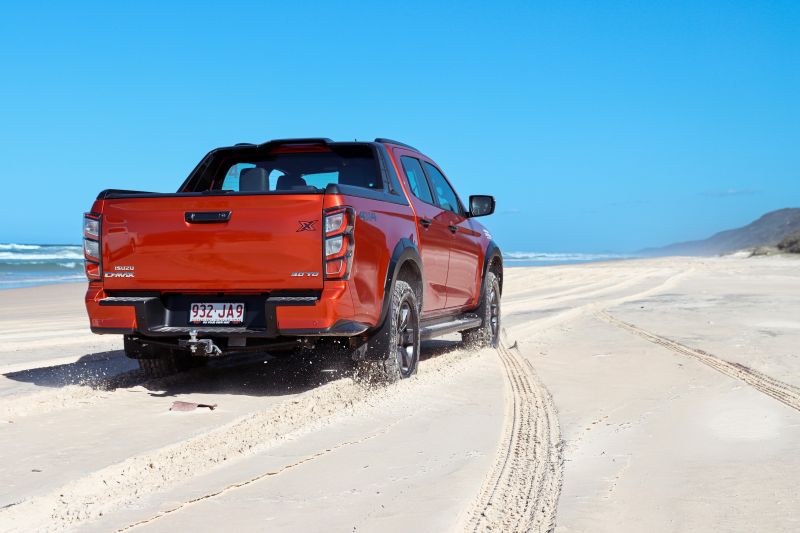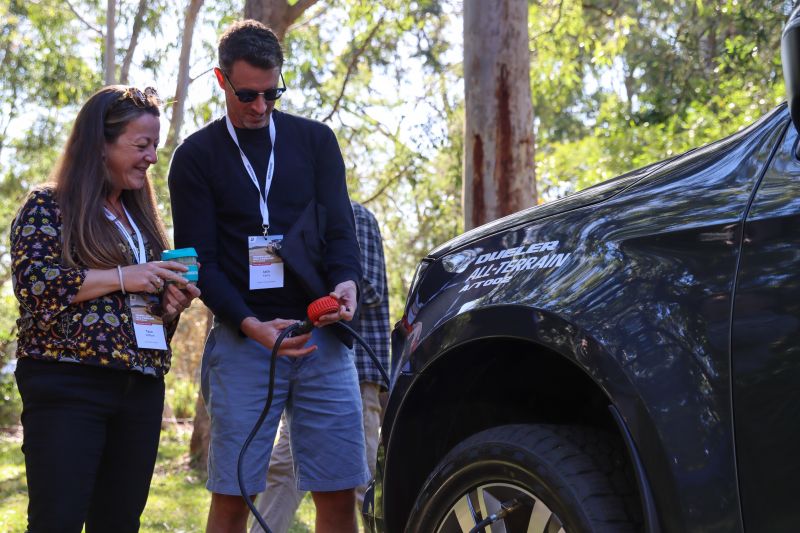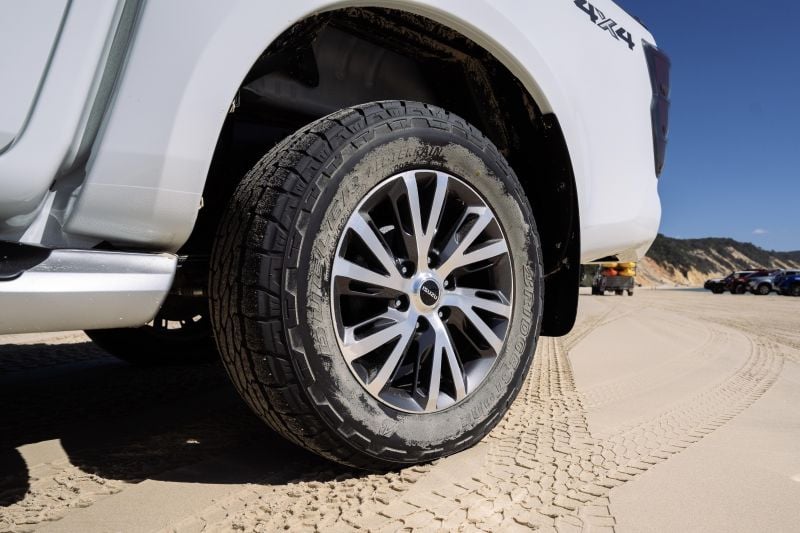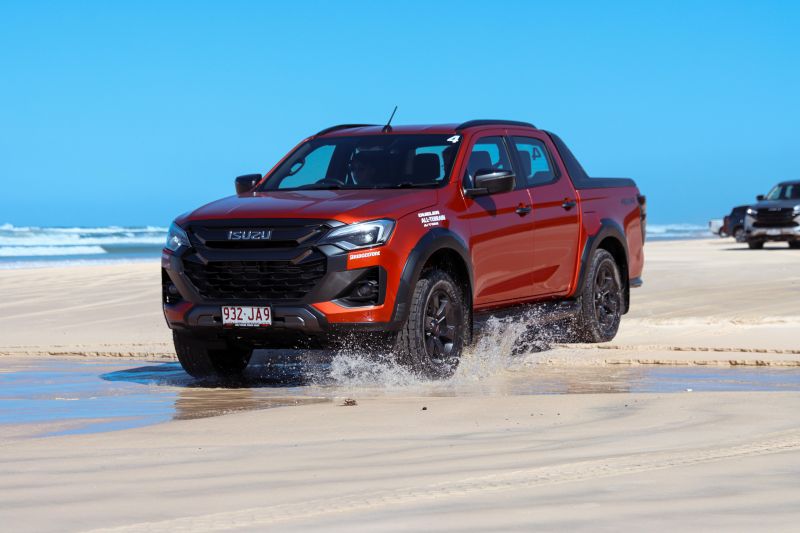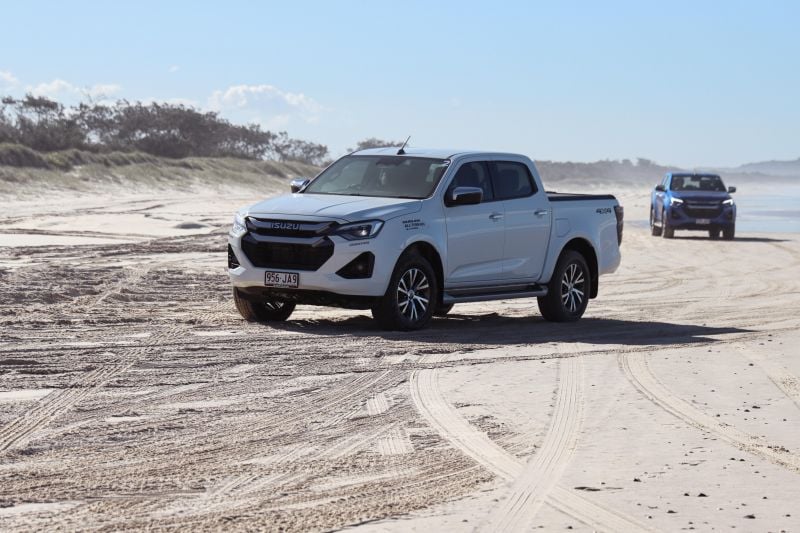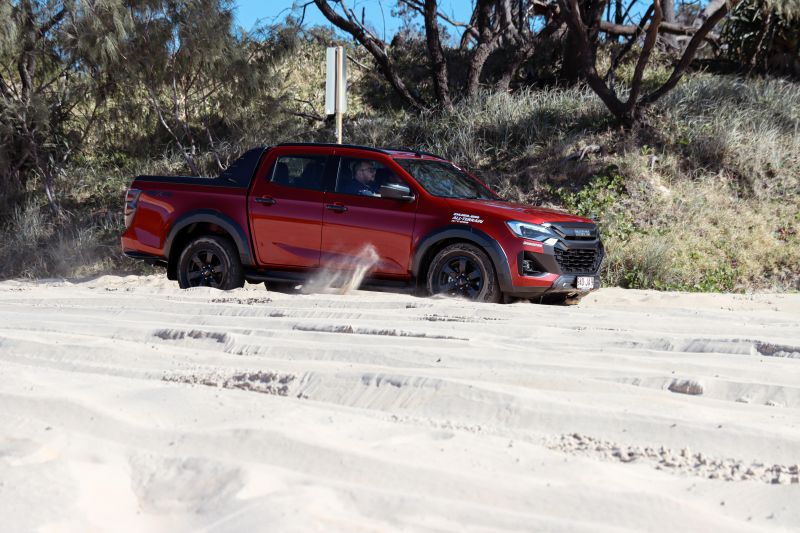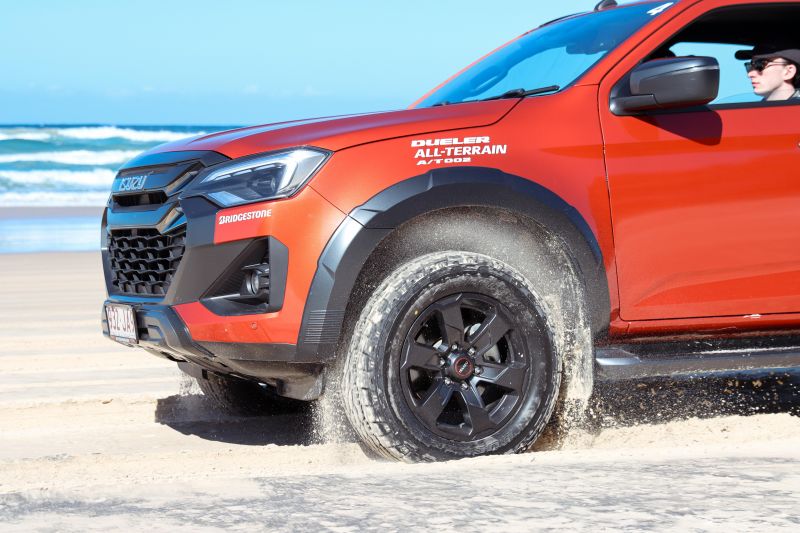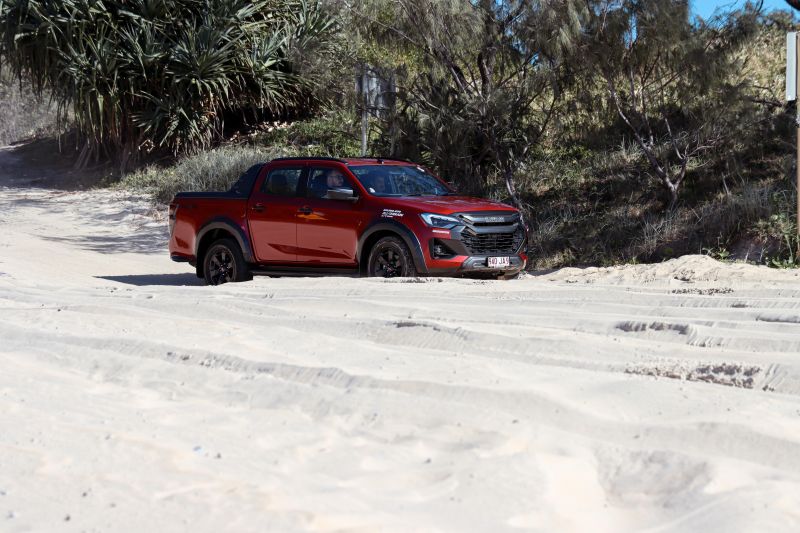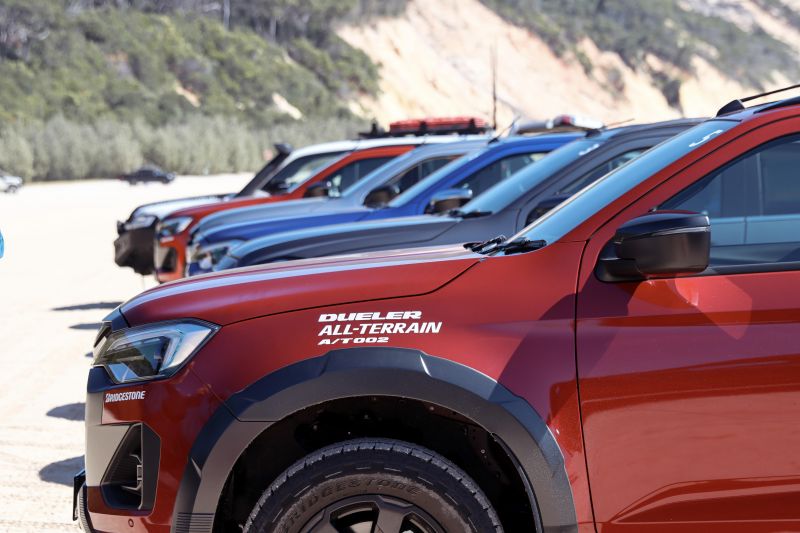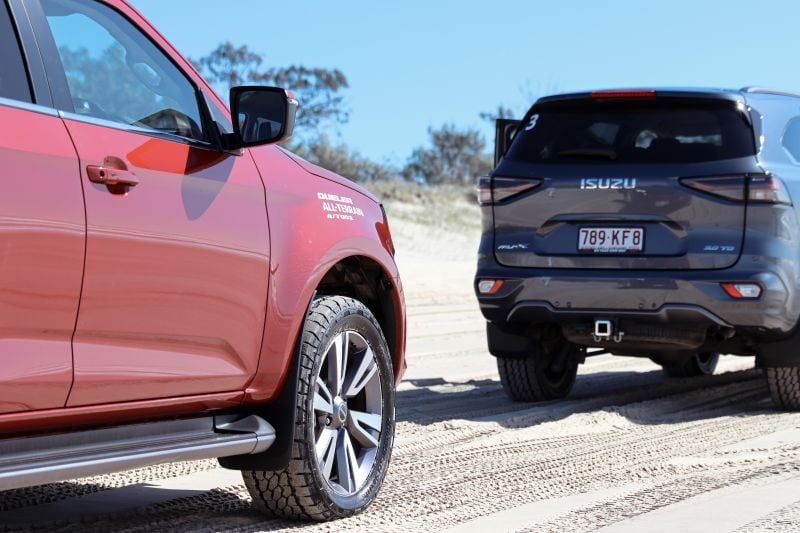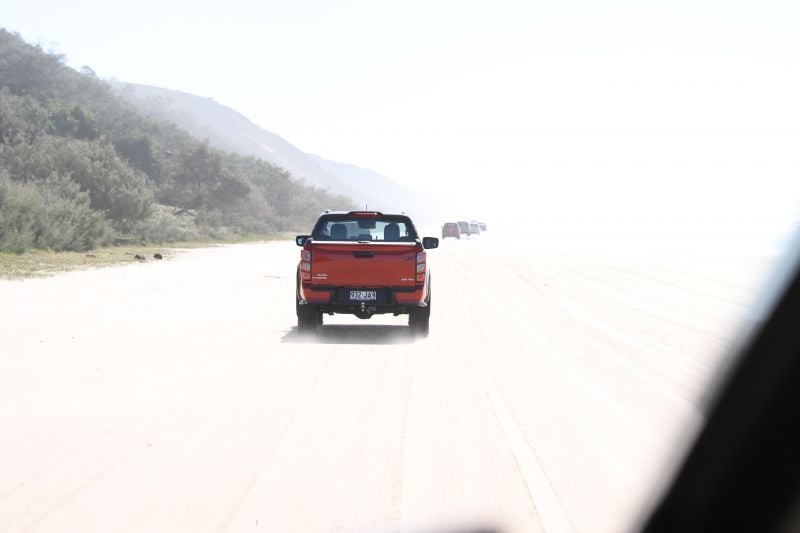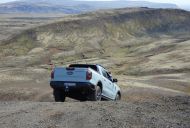Off-roading is as popular as it’s ever been in Australia, with people often heading out on national park bush tracks to access camping sites, or just enjoy the drive.
But you don’t have to stay firmly on dry land if you have a capable vehicle. We’re lucky enough in Australia to have the opportunity to take our four-wheel drive utes and SUVs on some of our expansive beaches, which is a privilege that comes with key responsibilities.
You can’t do it everywhere, but there are some stunning locations across the country where it’s allowed.
Queensland may take the cake for beach driving opportunities, with spots like K’gari, Rainbow Beach, and of course Noosa’s North Shore.
We were invited out to Noosa last week to test Bridgestone’s new Dueler A/T 002 all-terrain tyre, where a portion of the drive program involved a 100km return loop from Noosa North Shore to Double Island Point – driven entirely on the beach.
If you’re like me and had never taken a vehicle on the beach before (but are interested in having a go), here’s everything I learned both before and during the day’s driving.
We had the luxury of driving a fleet of various new Isuzu D-Max and MU-X models, all of which were more than up for the task.
We were lucky to have Australian Offroad Academy principal instructor and director Dave Darmody on hand to guide our 10-car convoy, so most of this article’s content is derived from his beach driving advice.
Preparation is key
While it’s important to have a capable, well-prepared car with four-wheel drive and appropriate tyres, Mr Darmody says the first step is to check the tides.
Tide estimations are published online up to three years in advance, which means there’s plenty of time to appropriately pick the time of year and day for your beach adventure.
As Mr Darmody says, “you can have the best prepared car, you could do your tyre pressures, but if it’s high tide it’s going to end badly”.
“Step one is to pick the best week if you’re planning a beach holiday to make sure the tides work … beach success is around getting the timing right,” he said.
Once you have your timing sorted, it’s time to worry about vehicle preparation. One of the main things to keep in mind is it’s always better to keep your vehicle as light as possible, as having extra unnecessary weight could mean you’re more likely to run into trouble – like getting bogged in the sand.
It’s also important to make sure you’ve got your tyre pressures right, as your tyres are the only thing connecting your car to the sand.
Mr Darmody says a general rule of thumb is to reduce your tyre pressures by about 30 per cent of the vehicle’s placard pressure.
That means if your vehicle says to inflate its tyres to 35psi, for example, you should let them down to about 25psi. It’s also worth remembering you’ll need to pump them up again after driving on the sand.
Having lower tyre pressure means you’ll have a larger contact patch with the sand, which means the vehicle’s weight is spread over a larger area and it’s harder to get yourself stuck. It’s important to note the contact patch doesn’t become wider, but instead becomes elongated with the tyre’s direction of rotation.
Many beaches will have an area to let air out of your tyres before you enter the beach. It’s worth noting you can let your tyres down with something as simple as a small twig, but to get an accurate reading you’ll need to use a pressure gauge.
You can buy cheap tyre pressure gauges from most auto stores, or if you know someone with an air compressor you can ask to borrow the nozzle on its own to control how much air you’re letting out. Better still, it’s possible to fit a portable air compressor that’ll be useful later on.
“It’s about knowing the beach terrain and tyre pressures, and having and understanding of what you’re actually trying to achieve with tyre pressures rather than just aiming for a number that some guy gave you on Facebook,” Mr Darmody said.
“You can’t underestimate the value of local knowledge. If you get onto a local group [who know and talk about the current conditions], it’s good to ask some sensible questions, and those people are more than happy to help you out.”
Otherwise, it’s always a good idea to have appropriate recovery gear onboard like tow ropes, some form of winch, an emergency radio, recovery boards, an air pump, and any necessary tools. Mr Darmody recommends brands like Maxtrax, which sells recovery boards, tyre pressure gear, and a range of four-wheel drive equipment.
How to approach sand driving
The beach is one of the most variable environments you could drive a car. Between the winds, water, and driving surface, there’s a lot to keep in mind as you’re motoring along.
Your first steps are to select high-range four-wheel drive and completely disable traction control. Most cars do this differently, but in the case of a D-Max it’s a matter of turning a large dial and holding down the traction control button for around five seconds.
Perhaps the most challenging aspect is the very start of your journey, as driving beaches are commonly accessed only by narrow cuttings through dense bush.
In the case of Noosa North Shore, entry to the beach at most points is done via such cuttings, which are narrow and full of soft, dry sand. Conveniently, these areas will typically have more beachgoers around on foot, which means there will be more eyes (and potentially cameras) on you if something goes wrong.
The key to entering the beach is to keep your momentum up and avoid squaring off turns too sharply. If you keep a consistent throttle input and maintain your speed, you should have no issues driving straight through and out onto the beach.
Unlike typical off-roading, there’s not much to be gained by picking a line early. Because sand is incredibly soft and malleable, the car will likely find the path of least resistance and direct itself through.
Once you’re on the beach, the same general rule applies. While driving generally becomes easier as a result of the damp, packed sand, you should still stay vigilant for hazards and take note of places to avoid placing the car.
Beaches will often be eroded by water in some places, which means you need to watch for short but sudden ridges and drop-offs. Depending on their size, these can just give you a bit of a surprise and a small amount of air time, or potentially damage your car if you hit them too fast.
It’s often better to stick closer to the water, as the sand is generally firmer and any bumps will have been flattened out by the incoming waves as they break over the sand. Just watch you don’t get too close to the water, as a small wave rolling over the sand could be hiding an unexpected hole.
You’ll often come across pieces of objects lost at sea and driftwood, so watch out for anything sticking out of the sand too.
If you prefer it’s possible to drive up closer to the dunes, but it’s best to avoid driving further inland. The beach is still a habitat for wildlife, so driving anywhere further inland than the first blade of grass puts plants and animals at risk.
Driving closer to the dunes often brings softer sand, so like when you first enter the beach you should keep your momentum up and let the car guide itself. It’s important to have confidence in the car and know it’ll continue forward so long as your foot is consistently on the accelerator pedal.
Just try to avoid hard braking or planting the throttle, as sudden changes in wheel speed could get you into trouble.
Also note that steering inputs do not register nearly as well when you’re on soft sand, so do your best to keep the wheel straight and avoid putting in a lot of steering lock when you’re travelling at speed.
Mr Darmody says it’s not impossible to make changes when you’re on the beach, and it’s encouraged to do so if you’re not feeling comfortable.
“If you’re having a hard time on the beach, if you feel like you’re bogging or like you’re fighting the car the whole time, there’s absolutely no face lost in stopping and taking a little bit more air out of the tyres,” he said.
“The conditions may have changed since the last report, it could just be a super windy day and the sand has dried out really quick, so you might find taking more air out makes all the difference. What goes from being a bit of a struggle then turns into an easy drive.”
When it comes time to leave the beach, it’s done by the same sandy cuttings. It’s important to keep your speed up and make sure turns are as wide and smooth as possible.
“There’s nothing at all wrong with just driving past a beach cutting so you can have a look. You might be able to see a better line, and you can spot that, turn around casually, and line up and give yourself a greater chance of success,” Mr Darmody said.
Getting stuck isn’t the end of the world
Bogging the car in a spot of soft sand is possible, but it’s worth knowing there are things that can be done to rescue yourself if need be.
Your first move should be to stop and reverse. Mr Darmody says “the deeper the hole you dig, the more trouble you’re in”, so sometimes taking the time to pause, select low range, and attempting to reverse out could be all it takes to get going.
If that doesn’t work straight away, your next move is to put the car in park and turn the engine off. Diesel engines in particular can rumble the vehicle further into the sand if they’re idling, plus it burns fuel.
Then you can go around to each tyre and let even more air out, because if you’re not completely stuck it could be all you need to find some extra traction to reverse out over your own tyre tracks.
“If you are bogged, say you gunned it and you buried the car a bit, your best friend are [recovery boards]. With judicious use of [recovery boards], you can get yourself out,” Mr Darmody said.
“Self-recovery is always better than having to wait for someone else to come along, because then you’re at the whim of how crazy that person might be.
“You’re hooking yourself up to some random and that might not go well, so self-recovery is always a better choice if you can.”
The beach isn’t made for you to drive on
While you’re allowed to use the beach as a highway, you need to remember it’s still a habitat for plants and animals.
Additionally, they’re still public places and there will be people around on foot. There are numerous designated areas for camping, people fishing, or families just out enjoying the sun, so you need to be aware of everyone around to make sure you’re not putting people in danger.
The two ways to keep safe are to stay on the wide, flat areas of beach that are safe for driving, while also paying attention to speed limit signs. Maximum speed on many beaches is 80km/h, though there are 50km/h and 40km/h zones where people camp, fish, and relax.
Road rules still apply, and you can be subject to fines if you’re caught doing anything that could put you, beachgoers, or other motorists at risk.
“I think some people get a little bit too focused on the speed limit, and not on paying attention to what’s going on around it,” Mr Darmody said.
“At the end of the day, driving on a beach is probably the most variable terrain you could take your car onto because there’s no centreline and the edge keeps changing.
“Sometimes it may take a little bit more attention to the job of driving and understanding that on some days, 80km/h might be unattainable, and maybe 40km/h is actually the maximum safe speed in any one place. It’s just about showing a bit of respect to the action of driving in such a variable location.”
Once you’re done on the beach, you still need to be sure you’ve prepared your car to go back on the road. The first step is to select high-range two-wheel drive, re-engage traction control, and re-inflate your tyres to placard pressure. That last step can be done with either an onboard air compressor or a conventional pump.
There are also stations not far from the beach where you can wash the underside of your car, which helps to keep roads clean and minimise the risk of corroding metal components under your car in the long term.
With all that in mind, the key thing is to enjoy yourself. Australians are lucky to be able to drive their own cars on the beach against the backdrop of blue skies and seas, so it’s important to take care and show respect if you choose to do so.
If you pay attention to keeping yourself and others safe while following the relevant rules, you can make sure everyone can continue to enjoy their cars on our beaches into the future.





